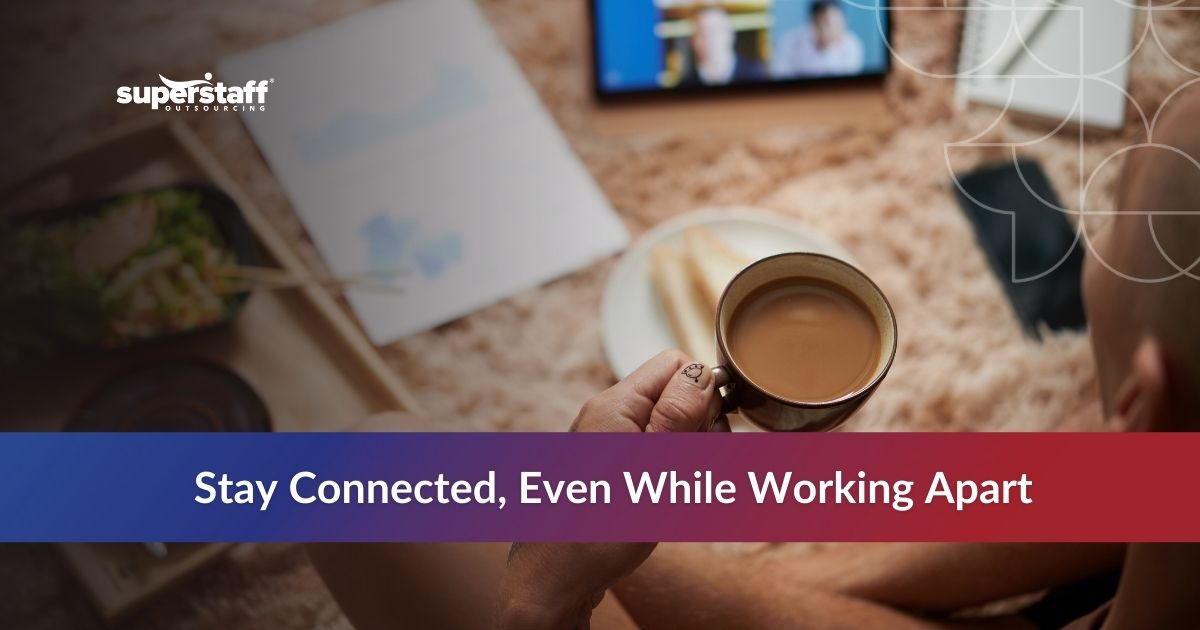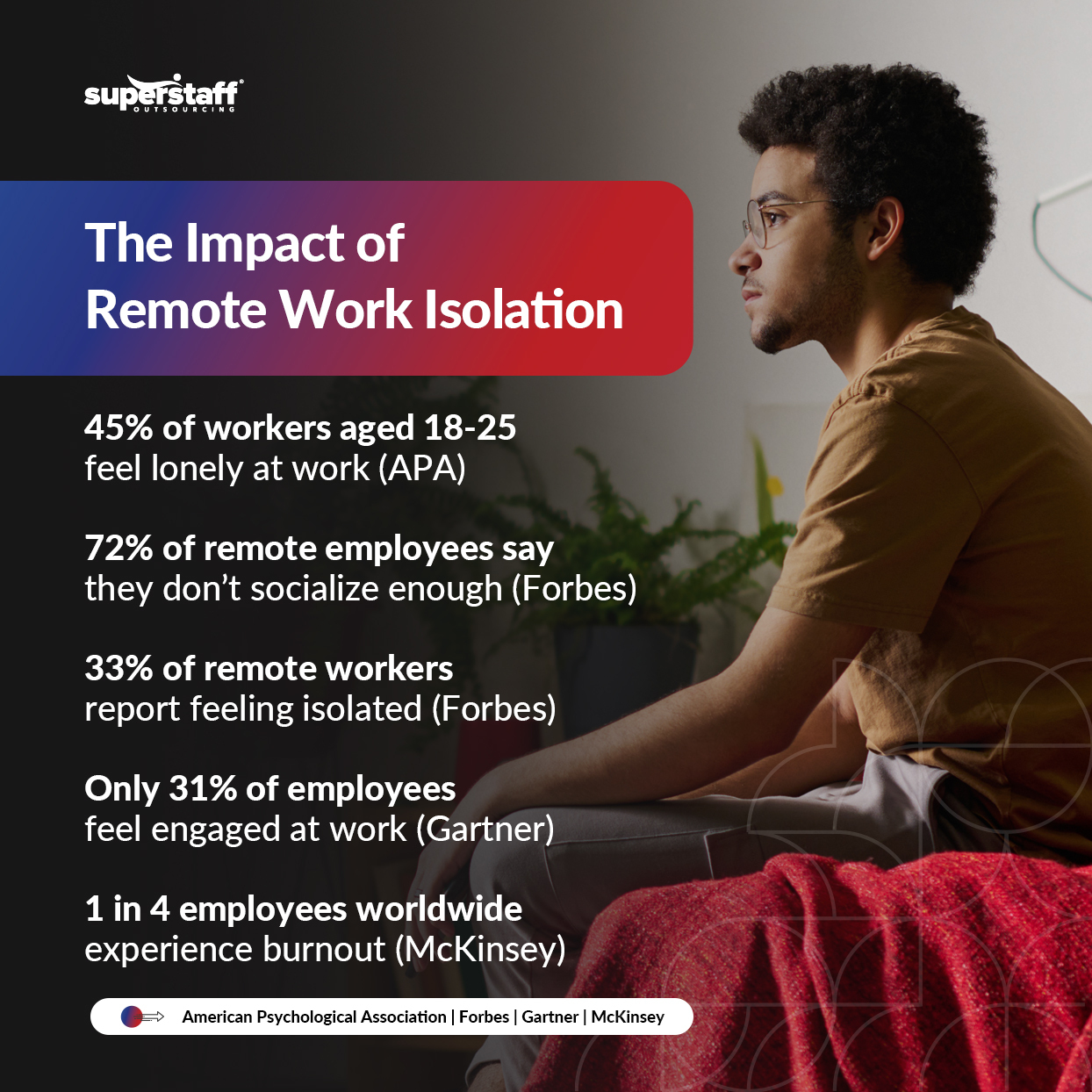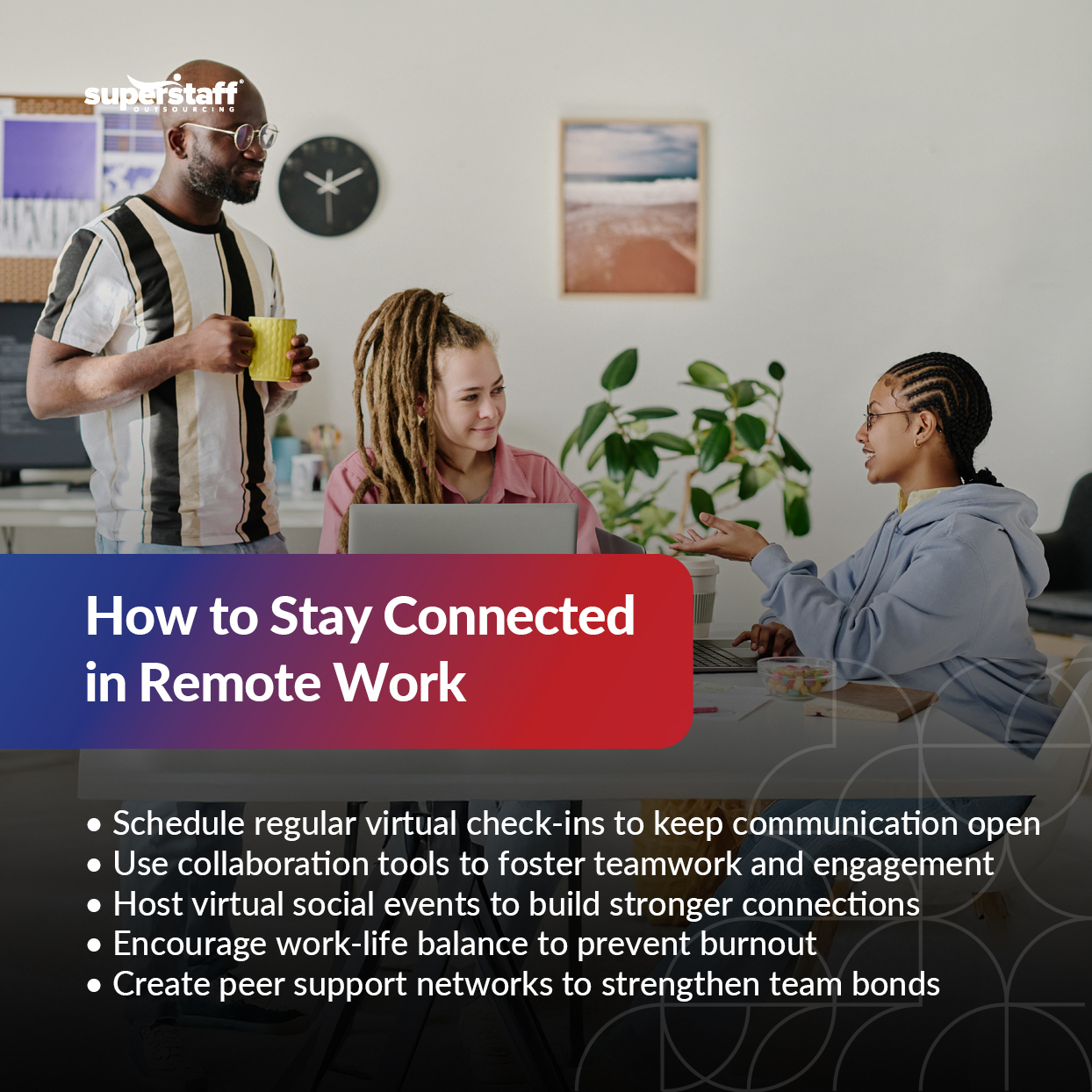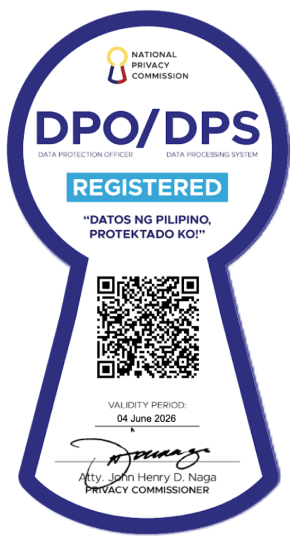
Remote work offers flexibility and convenience, but it also brings an unexpected challenge: loneliness.
Many employees find themselves feeling disconnected, even while excelling in their roles. Without the daily interactions of a physical office, virtual work can quickly become isolating. While productivity may remain high, the absence of in-person connections can affect mental well-being and engagement.
This article explores the impact of remote work isolation and offers practical solutions to keep employees connected. By prioritizing communication, fostering virtual team-building, and promoting a strong company culture, your business can create a more inclusive and engaging remote work environment.
Understanding Isolation in a Virtual Work Environment

Remote work has changed the way we do business, giving employees more flexibility than ever. But while skipping the commute and working in sweatpants sounds ideal, there’s a hidden challenge that many don’t talk about—feeling disconnected.
Without the usual office banter or quick chats by the coffee machine, remote workers can start to feel like they’re operating in a silo. Conversations that once happened naturally in the hallway now require a scheduled meeting, and over time, that lack of spontaneous interaction can take a toll.
It’s not just about work productivity—it’s about human connection. According to the American Psychological Association (APA), nearly 45% of workers aged 18–25 report feeling lonely at work. For younger professionals who may be new to the workforce, remote setups can make it even harder to build personal connections with coworkers. Instead of forming friendships over lunch or team outings, they’re left with transactional Slack messages and video calls that feel more like check-ins than real conversations.
This isolation doesn’t just affect morale—it can impact performance too. Without regular social engagement, employees may struggle with motivation, feel disconnected from the company’s mission, or even find it harder to stay focused.
The good news? Loneliness in remote work isn’t inevitable. Companies that prioritize connection, even in a virtual setting, can foster an engaged and thriving workforce. It all starts with creating opportunities for meaningful interactions.
Encouraging Regular Virtual Check-Ins and Meetings
Working remotely has its perks—no commute, more flexibility, and the comfort of home. But without those casual “How was your weekend?” chats or quick catch-ups between meetings, staying connected with coworkers can be tough. Remote work isolation isn’t just a buzzword; it’s a real issue that affects engagement and morale. In fact, according to Forbes, 72% of workers say they don’t get enough social interaction when working remotely, and 33% report feeling lonely.
The fix isn’t just more meetings—it’s better ones. Structured check-ins, like weekly team huddles and one-on-one meetings, give employees a chance to align on goals while also reinforcing a sense of belonging. But the best connections often happen outside of formal work discussions. Virtual coffee chats, casual brainstorming sessions, or even lighthearted team Slack threads can go a long way in breaking the monotony of remote work.
When companies make intentional space for both work and social connection, employees feel more engaged. Regular check-ins aren’t just about staying productive—they’re about making sure no one feels like they’re working in isolation.
Leveraging Digital Collaboration Tools
Staying connected in a remote work environment isn’t just about having the right technology—it’s about using it in a way that keeps teams engaged and energized. The problem? Many employees still feel disconnected.
Gartner research highlights a concerning trend in remote workplaces—only an underwhelming 31% of employees feel truly engaged and excited about their work. This lack of connection can make remote work isolation even more challenging, as employees struggle to find enthusiasm without the natural energy of an in-person team. Without the right tools and strategies to foster collaboration, remote employees can feel like they’re working in silos rather than as part of a dynamic, connected workforce.
That’s why businesses need to go beyond basic messaging apps. Sure, Slack, Microsoft Teams, and Zoom make communication instant, but real connection comes from creating interactive and engaging digital spaces. Virtual whiteboards spark creativity in brainstorming sessions, shared task boards keep projects on track, and document co-editing tools make collaboration seamless.
But it’s not all about work. The strongest teams also connect on a personal level. Dedicated Slack channels for hobbies, wellness, and industry trends give employees a space to bond beyond their daily tasks. Some companies even gamify productivity, turning routine work into friendly competitions that bring people together. When businesses invest in tools that foster both collaboration and camaraderie, remote teams don’t just function—they thrive.

Creating Virtual Social Events and Team Bonding Activities
Think back to your last job in a traditional office. Maybe it was the impromptu coffee runs, the laughter during lunch breaks, or those after-work hangouts that made the workplace feel more than just a place to earn a paycheck. In a remote setting, those moments don’t just happen—you have to create them. Without intentional effort, remote work isolation can make employees feel like they’re just logging in and out without any real connection to their team.
That’s why virtual social events matter. They’re not just for fun; they’re essential for keeping teams engaged and motivated. In fact, Forbes reports that employees who receive social recognition at work are 3.7 times more likely to be engaged and 55% less likely to job hunt. Virtual happy hours, trivia nights, or even online escape rooms aren’t just distractions—they help remote teams build the same camaraderie that in-office employees naturally develop.
Beyond structured events, personal connections make all the difference. Encouraging employees to start virtual book clubs, fitness challenges, or casual Slack groups for shared interests can create an environment where people feel valued beyond their job titles. When companies take the time to foster real relationships—even from a distance—employees don’t just stay productive. They stay connected.
Promoting Work-Life Balance to Reduce Burnout
Remote work promises freedom—no long commutes, more flexibility, and the ability to set your own schedule. But without clear boundaries, it can quickly become overwhelming. The laptop that sits on your desk during work hours is still there at night, tempting you to answer just one more email. Before you know it, work spills into personal time, and exhaustion sets in.
Burnout isn’t just an individual problem—it’s a widespread issue. According to McKinsey, a global survey of nearly 15,000 employees across 15 countries found that one in four employees experience burnout. When employees struggle to unplug, they risk becoming disengaged, less productive, and even questioning whether they want to stay in their roles.
Businesses need to step in. Encouraging clear working hours, setting expectations for response times, and normalizing breaks can help employees create a sustainable routine. Companies that actively promote mental health—whether through wellness programs, guided meditation sessions, or digital detox initiatives—show their employees that their well-being matters.
Work-life balance isn’t just about taking time off; it’s about creating a culture where employees can thrive without feeling constantly “on.”
Encouraging Peer-to-Peer Engagement and Support Networks
Connection isn’t just about leadership initiatives—it’s also about fostering peer relationships. Encouraging employees to build networks within their teams can strengthen workplace culture and improve job satisfaction.
One way to do this is through employee resource groups (ERGs), where workers with shared interests or backgrounds can support one another. Virtual mentorship programs also provide valuable guidance, particularly for new remote employees adjusting to their roles. Whether through structured mentorship or casual peer groups, these initiatives make remote employees feel seen and supported.
Measuring and Adapting Virtual Engagement Strategies
For businesses to maintain a thriving remote workforce, they need to continuously assess and refine their engagement strategies. Regular pulse surveys, employee feedback forms, and virtual town halls can provide insight into what’s working and what needs improvement.
Leadership teams should remain flexible and willing to adjust virtual policies based on real employee experiences. By staying responsive to feedback, companies can create a more dynamic and inclusive remote work culture that prioritizes connection.
The Future of Remote Work and Employee Connection
As businesses embrace long-term remote work, prioritizing connection is no longer optional—it’s essential. The rise of hybrid models will likely reshape how companies approach virtual engagement. New AI-driven communication tools may further personalize the remote work experience, making it easier for employees to interact seamlessly.
Future-focused businesses must continue investing in digital workplace communities and engagement strategies. By doing so, they can cultivate a strong, connected workforce that thrives no matter where employees are located.
Overcoming Remote Work Isolation With the Right Support
Remote work isolation is more than just missing office small talk—it’s a real challenge that can affect engagement, productivity, and overall well-being. However, companies that take intentional steps can build a virtual work culture where employees feel connected and valued. Frequent virtual check-ins, interactive collaboration tools, and social events help bridge the gap, ensuring that remote employees stay engaged. Prioritizing work-life balance and fostering peer-to-peer relationships further strengthens a team’s sense of belonging.
At SuperStaff, we understand the importance of connection in a virtual work environment. As a leading customer support outsourcing Philippines provider, we specialize in helping businesses create seamless, people-centered remote teams. Whether you need outsourced customer service Philippines solutions or back office service provider Philippines support, our expertise ensures that your remote team remains engaged, efficient, and aligned with your company’s goals.
Isolation doesn’t have to be a part of remote work. With the right strategies and the right partners, businesses can build strong, connected teams no matter where their employees are. Let SuperStaff help you create a thriving virtual workforce. Contact us today to learn more!






